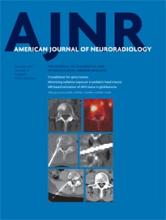Abstract
BACKGROUND AND PURPOSE: Contrast agent extravasation has been shown to confound brain tumor perfusion measurements with DSC–MR imaging, necessitating the use of correction techniques (eg, Weisskoff, Bjornerud). Leakage parameters (K2 and Ka) postulated to reflect vessel permeability can be extracted from these correction methods; however, the biophysical interpretation of these parameters and their relationship to commonly used MR imaging measures of vascular permeability (eg, contrast agent volume transfer constant, [Ktrans]) remain unclear. Given that vascular density, as assessed by blood volume, and vascular permeability, as reflected by Ktrans (and potentially K2 or Ka), report on unique and clinically informative vascular characteristics, there is a compelling interest to simultaneously assess these features.
MATERIALS AND METHODS: We acquired multiecho DSC–MR imaging data, allowing the simultaneous computation and voxelwise comparison of single- and dual-echo derived measures of K2, Ka and Ktrans in patients with glioma. This acquisition enabled the investigation of competing T1 and T2* leakage effects and TE dependency on these parameters.
RESULTS: K2 and Ka displayed nonsignificant (P = .150 and P = .060, respectively) voxelwise linear correlations with Ktrans, while a significant (P < .001) inverse relationship was observed between K2 and Ka (coefficient of determination [r2] = 0.466–0.984). Significantly different (P < .005) mean estimates were found between voxels exhibiting predominately T1 and T2* effects for K2 and Ka. Ktrans, however, was observed to be similar between these voxels (0.109 versus 0.092 minutes−1). Significant differences (P < .001) in extracellular-extravascular volume fraction (ve) (0.285 versus 0.167) were also observed between cohorts. Additionally, K2 and Ka were found to have a significant quadratic relationship (P = .031 and P = .005, respectively) with ve.
CONCLUSIONS: Estimates of vascular permeability in brain tumors may be simultaneously acquired from multiple-echo DSC–MR imaging via Ktrans; however, caution should be used in assuming a similar relationship for K2 and Ka.
ABBREVIATIONS:
- CA
- contrast agent
- DCE
- dynamic contrast-enhanced
- Gd
- gadolinium
- Ka
- apparent transfer constant
- K2
- leakage parameter
- Ktrans
- volume transfer constant
- R1
- longitudinal relaxation rate
- R2
- transverse relaxation rate
- ve
- extracellular extravascular volume fraction
- R2*
- effective transverse relaxation rate
- © 2016 by American Journal of Neuroradiology
Indicates open access to non-subscribers at www.ajnr.org












